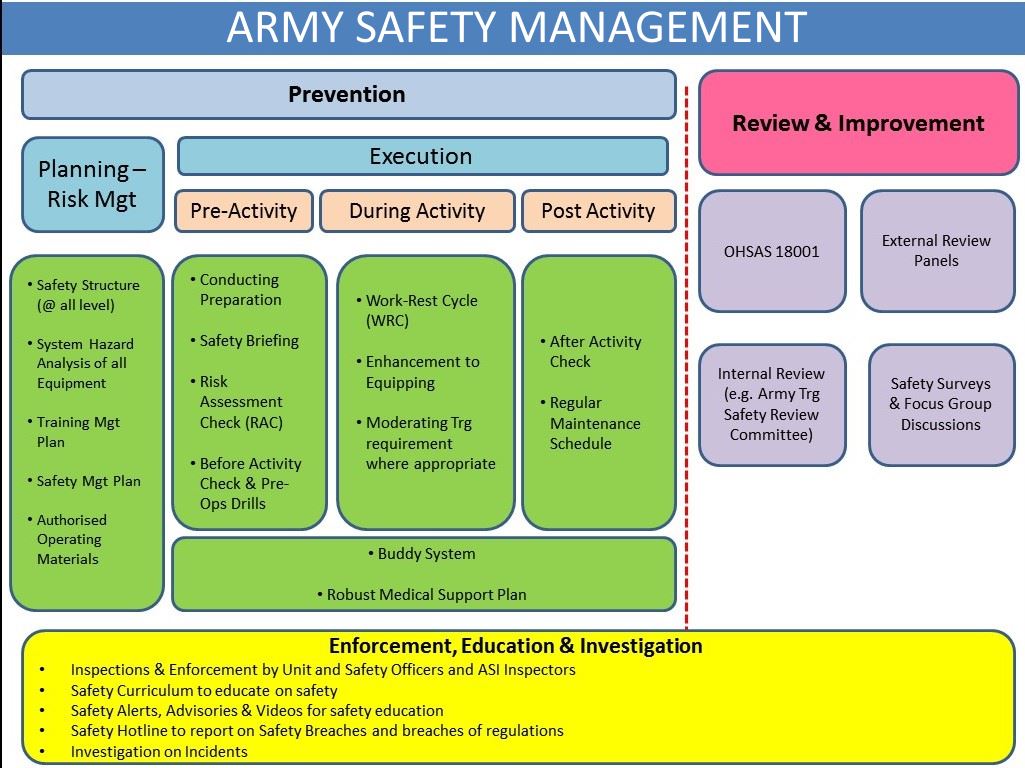 Web Content Viewer
Web Content Viewer
Overview
Safety is one of the Army's core values and is integral to mission success. Safety enhances our soldiers' confidence and enables the Army to conduct tough and realistic training and to operate effectively during missions. The Army safety system is benchmarked to international safety standard (OHSAS 18001), with continuous improvements made through regular internal reviews and external feedback from safety experts such as the External Review Panel for SAF Safety (ERPSS).
The Army takes a comprehensive approach in planning and executing training safely. There are safety measures put in place at all phases to mitigate the risk, and a robust medical support plan to manage injuries should incidents occur. Refer to Figure 1 for the Army Safety Management Approach.
Figure 1: Army Safety Management Approach

Safety is an Individual Responsibility
Upon enlistment, servicemen are briefed on the Army safety system. This includes the buddy system where servicemen are told to look out for one another, and to take responsibility for their own safety. They are also reminded to sound off to their commanders when they are unable to participate in training through a risk assessment process. All servicemen can call for safety stoppages when they spot any safety breaches during training. Safety education is constantly reinforced throughout the two years of Full-Time National Service and ten years of Operationally Ready National Service.
Safety is a Command Responsibility
Our commanders are trained in command schools on the requirements on how to conduct training safely. Safety education and training are also constantly reinforced in the various courses that our commanders go through as they progress in their career.
Prior to the conduct of exercises, whether local or overseas, commanders who undertake responsibilities as the conducting staff will carry out thorough planning, reconnaissance, and coordination. They will also enforce the various safety regimes (e.g. work-rest cycle, temperature-taking, hydration, heat acclimatisation etc.) to ensure that their soldiers are suitably prepared to undertake training progressively. They will develop a safety management plan to identify potential risks and establish mitigating measures, and a medical support plan to ensure the training has adequate medical coverage. Our commanders will also conduct safety briefings and pre-ops drills, covering emergency procedures (such as vehicle overturning drill) for their soldiers, and they will be required to take Training Safety Regulation (TSR) tests annually, and before any high risk activity such as live-firing.
During training, our commanders are responsible for planning a proper work-rest-cycle to ensure their soldiers have sufficient rest. Our commanders are also expected to exercise their judgement to moderate the training intensity according to ground conditions to ensure the safe conduct of training. Post training, they are required to conduct after activity safety checks to ensure everyone (inclusive of the supporting staff) is well and accounted for before the safety and medical assets are released.
Safety is an Organisational Responsibility
The Army is benchmarked to the internationally recognised standard of Occupational Health and Safety Assessment Series (OHSAS) 18001. Since 2013, the SAF has commissioned an ERPSS, comprising prominent safety experts and professionals from outside the SAF, to review various aspects of SAF safety. At the system level, there are safety committees at the various levels of command (i.e. Battalion, Brigade, Formation/Division and Army) to oversee safety in the Army. There are also various safety and technical specialist forums (e.g. Army Safety Board , Land System Safety Review Board etc.) to manage risks when new equipment and platforms are being introduced into the Army. The Army also constantly reviews our soldiers' equipping (e.g. hybrid uniform, load bearing vest etc.) to enhance ergonomics and safety. TSRs and authorised operating materials (AOMs) are regularly reviewed, while inspections and audits on ground compliance to safety regulations are regularly conducted by unit commanders, safety officers, and external safety teams.
The Army is committed to strengthening and sustaining a safety culture for all servicemen. Near miss reporting is encouraged, and an Army safety hotline was established to allow feedback on various safety issues. Safety surveys and focus group discussions are also held regularly to solicit ground feedback on safety issues and concerns. Bite-sized infographics and videos are also developed regularly to facilitate the absorption of safety knowledge and content. Additionally, safety indicators and safety trends are monitored and safety advisories are issued for accident prevention. Past incidents are also disseminated timely and widely to allow learning.
In the unfortunate event of any incident, the Army will investigate thoroughly to establish the causal factors to make improvements to prevent future occurrences. This is in addition to any other investigations that may be conducted . Servicemen, including commanders, who were found to be negligent, will be held accountable. Where applicable, the Army will convene separate expert panels to provide advice and expertise on specific safety issues.
